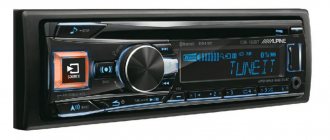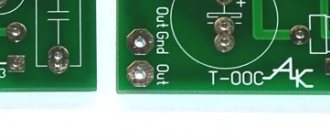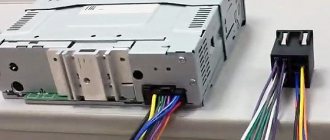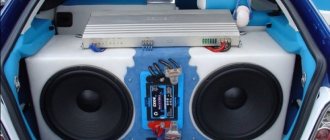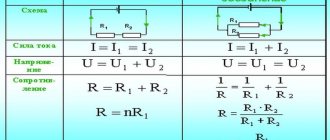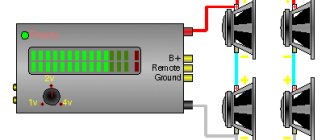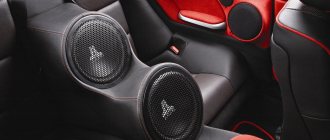Along with highly specialized speakers that reproduce sound from specific frequencies, there are full-range speakers that select mid frequencies as the main band, but connect both lower and upper frequencies to them. Of course, with cheap equipment the sound seems very poor, but by purchasing high-quality equipment you can improve it significantly. True, it is believed that such a mixing of frequencies in any case produces distortion, so such dynamic radiators are not suitable for special connoisseurs of high-quality music reproduction.
Basic information about full-range speakers
High-quality acoustics, which have a built-in full-range speaker, cover the entire frequency spectrum, without the need to overload the system with several speakers. This feature allows listeners to save themselves from having to buy a crossover, which is necessary to color the sound. In practice, such a speaker is quite enough for the sound to be rich, but a lot depends not only on the emitter, but also on the box and, in particular, the device manufacturer.
Thus, the English company Lowther produces truly high-quality broadband speakers that can compete with an entire speaker system. Products under the Fostex brand have also spread throughout the world and can be included among the top brands in this field. In addition to the above brands, speakers with full-range speakers produce:
- Saba;
- Jordan;
- Diatone Mitsubishi;
- Reps,
- Supravox;
- Kinap LOMO;
- Fertin;
- Radio Shack;
- Sonido;
- Noema;
- Telefunken and others.
True, not all speakers declared as broadband reproduce the entire spectrum of frequencies. For many, it is necessary to purchase additional equipment in the form of a crossover or tweeter so that they are able to fully cover the audio range.
Types of Full Range Speakers
There are two types of full-range speakers:
- with central cap;
- with a cone-visor “dudka”.
The first resembles a simple speaker with a single dome cone built into it. The second has two cones, one of which is large, as in standard speakers, and the other, smaller, is located inside the larger one.
Additionally, full-range speakers can vary widely depending on manufacturer and design. This means that some speakers produce virtually no distortion, have high efficiency and sensitivity, but do not produce low frequencies well. To smooth out this drawback, it is necessary to develop a special box that increases bass. The high performance of full-range speakers allows you to limit yourself to low-power amplifiers (UP TO 3 W). Other full-range speakers deliver sound well across the entire frequency spectrum, but are less efficient. In addition, they require a stronger amplifier.
Is there a need for full-range speakers?
Broadband speakers are clearly inferior to their analogues, since one emitter cannot effectively convert the entire frequency spectrum. The result is sound distortion, lack of volume and depth. True audio connoisseurs are categorically against such devices, as they feel the difference in sound quality. But there are situations where full-range speakers can work just fine.
They are often used in cars, since not everyone can install a powerful speaker system in a vehicle, and not everyone needs it. To listen to pop music, there is no need to connect bass and high-frequency sounds. At the same time, distortions in the transmission of sound waves are unlikely to become the primary determining factor for equipping a car with a powerful and expensive system.
Full-range speakers are preferred by people who do not take sound quality into account. The midrange frequencies are enough for them, which can be easily handled by radiators of this type, so they don’t think about assembling an acoustic system consisting of several elements.
Comparison of full-range speakers from different manufacturers
If you set out to study the market for full-range speakers, you will find that it is not so rich in truly high-quality systems with a single speaker responsible for reproducing all frequencies. For example, Diatones produces similar devices, but they do not reach the high quality of bass conversion.
To a greater extent, speakers released in the 80s meet high quality standards. They capture low frequencies from 30 Hz, and reproduce high frequencies up to 16 kHz. Of course, this is not full coverage of existing sound waves, but it is enough for maximum color when operating a single speaker. This rarity is due to the fact that finding or creating a full-spectrum speaker is extremely difficult. You can get out of this situation by installing at least two speakers responsible for different ranges, but this already goes beyond the concept of a wideband speaker.
In this regard, most manufacturers who indicate that the speakers are equipped with a full-range speaker additionally build in elements that smooth out the speaker's shortcomings. For example, most add bass, but this also does not improve the sound quality. Mixing the speakers is difficult to perceive by ear, while resonant vibrations from the subwoofer only spoil the sound of the mids and highs.
Horn loudspeaker systems
Trying to “tame” as wide a range of sounds as possible with the help of full-range speakers, manufacturers are faced with a number of problems. It all depends on what range of sounds needs to be produced.
Low sensitivity systems exhibit a narrow dynamic range, especially when the volume is lowered. This is expressed in the loss of high and low components, which are “clogged” with mid-frequency sound. This is partly due to the structure of the human ear, which is most optimally adapted for the perception of medium sounds.
As for high frequencies, the sound emitted by a small diaphragm of a tweeter with a small amplitude is simply lost against the background of the same mid frequencies. The solution to this problem is found in the use of additional devices (timbre blocks, frequency response correctors, tone compensators, etc.), which worsen sound reproduction.
An alternative is a fundamentally different way to improve sound reproduction - improving the efficiency of acoustic systems using horns (horns). This original design makes it possible to correlate the pressure of the external air environment and the sound pressure of the diaphragm of the emitters. This leads to minimization of distortion and equalization of the amplitude-frequency characteristics of wideband speakers.
In the Soviet Union, they were very fond of creating horn acoustic systems based on 4A-28 broadband speakers, for example: An acoustic unit with increased efficiency at low frequencies.
Rice. 1. Wideband speakers 4A-28
Design features that enhance the quality of full-range speakers
As mentioned earlier, full-range speakers often focus on the mids and highs, while neglecting the lows. At the same time, most listeners strive to provide themselves with bass, too, so they resort to various tricks to eliminate this shortcoming. It is precisely because of the problems with the lack of bass that many do not consider speakers with a polypropylene cone, which does not show itself on the positive side. The best speaker sound is achieved with a cone made of paper. A modern alternative is Kevlar.
When choosing a wideband speaker, you should pay attention to the diaphragm, which should not be large. The movement of the cone must also be moderate, otherwise there will be a problem with the transmission of high frequencies, which will also lead to significant distortion. To increase bass, you can increase the size of the cone while leaving the cone stroke at the same level. True, such actions will only help if a high-quality diffuser is built into the speaker.
For wideband speakers, it is best to use paper or plastic, for example, polypropylene, diffusers. Kevlar, aluminum and resin are also very popular. Paper is good because it does not have high rigidity like metal, but this reduces its resonance. To improve this parameter, the material can be varnished.
Wideband playback - factory kit for mid-range cars
Speakers with full-range playback of 8 cm, 10 cm, 12 cm are installed on most factory conveyors. They may or may not suit you, but the sound quality will depend on the manufacturer. The choice of this option is associated with the reproduction of low and high frequencies without a crossover. Many audiophiles are sure that this is how the purity of sound is determined, but there is one “but”.
Car speakers
It is as follows: the larger the body, the better it reproduces low frequencies and the worse it reproduces high frequencies. Large full-range speakers, first of all, cannot boast of smooth sound frequency at high frequencies. Mid-size speakers usually have smooth high frequencies and good dispersion (more on that later). Within the range of 5-7.5 MHz they sound great, but even a non-specialist can understand that there is not enough bass. Despite all the shortcomings, wideband speakers are an excellent addition to speakers, since they are small in size and, accordingly, suffer in bass reproduction. Large versions up to 10 inches are the best.
Dispersion characterizes its ability to scatter sound in all directions. If the speaker has poor dispersion, the sound will be very similar to the sound of acoustics under a blanket. If in a store you hear a good natural sound from a speaker, then everything is fine with dispersion in this model. The same applies to bass; improved samples are additionally equipped with a subwoofer, compensating for the lack of low frequencies. 10-inch devices will help you get high-quality low frequencies.
Car speakers
Results
Having reconsidered the above information and answered my question about how coaxial acoustics differs from component acoustics, I propose to summarize some results:
- There is no need to change the standard acoustics for those who use their radio for half an hour once a day just to listen to the news;
- A small car is also not a very good option for installing a component speaker system, since the small space in the interior of such a car simply physically cannot fully reveal the entire spectrum of frequencies, and the acoustics themselves will take up almost the entire usable area of the trunk (if, of course, it can be crammed there);
What is the difference between component and coaxial acoustics?
- Well, for those who “tread on the bear’s ear” or are simply not a big fan of high-quality sound, it is simply not advisable to pay a high price for a “pumped up” system, you most likely will not feel a noticeable difference;
- If you are still a fan of high-quality sound or consider yourself one, then saving on acoustics is simply not acceptable for you; there is only one road laid out for you - a good quality component speaker system.
What is the difference between component acoustics and coaxial acoustics?
In conclusion, I would like to ask you not to neglect the knowledge you have acquired when choosing the speaker system you need, and please be careful - excessive noise is a distraction, which cannot but affect the quality of driving.
Content:
What are the requirements for columns and features of model selection?
If you have not yet decided what interests you from broadband acoustics 8 cm, 10 cm, 12 cm, fill out a short questionnaire:
- speaker size;
- price range;
- requirements for HF and LF.
- dispersion requirements.
In principle, all these parameters can be assessed by ear with a certain degree of approximation; the main thing is to know the criteria by which high-quality speakers are selected. This way you can determine which option is the best for your personal preference package.
Car speakers Pioneer
When listening to an acoustic device, please note:
- on the naturalness of sound (dispersion): decent reproduction of the broadband range gives a rich sound spectrum with natural features;
- for low frequencies in small acoustic devices (a 12 cm wideband speaker requires a subwoofer);
- for high frequencies in large speakers (8 cm wideband speakers can act as a “tweeter”, that is, designed to reproduce high frequencies);
Car speakers (16 cm) Focal Access 165 AC
Turn the volume control and check the sound at different playback ranges.
Important! When choosing, it is worth considering that the speakers will sound differently in the cabin. This is due to the characteristics of a closed space. In addition, in theory, a full-range speaker is often used in a mono configuration, as it reproduces the full range of frequencies. In combination with other models, you need to carefully approach the choice.
There are two ways to solve the problem of playback in the cabin:
- purchase a radio with a sound processor that compensates for the shortcomings;
- test devices installed in the cabin;
- configure the sound using homemade elements (if you have the skills).
That is, if there is an opportunity to replace the product, do not rush to refuse it. High-quality sound requires sacrifice.
Rating of full-range acoustic devices: which ones to choose
It is quite difficult to recommend fundamentally different devices that provide excellent acoustic functions, but we will try to do it. First of all, the case must be with a bass reflex, that is, ventilated.
This is not always feasible, but it is desirable. Overall the bass in these versions will not sound good and the treble will be quite flat. Some audio companies provide improved speaker performance, meaning that some full-range devices will sound better than others.
Acoustic speakers Infinity
Coaxial models are recommended as a replacement for these models; they contain emitters for different ranges of sound frequencies. Such models provide better quality sound and are preferable for cars. Thus, this option would be a suitable full-range speaker system for cars.
For coaxial car speakers the rating is as follows:
- FOCAL 165 AC - one of the suitable 16 centimeter ones, inferior to the component system, but sounds great;
- Morel Tempo Coax 6 – made of fiberglass, therefore it gives well-balanced bass and midrange. They have a high-quality diffuser for low frequencies;
- Infinity REF-6522ix is an excellent two-way system;
- Pioneer TS-1339 – reproduces bass and mid frequencies well, so it is very popular among buyers of inexpensive but high-quality sound.
Speakers Pioneer TS-1339
Thus, the best full-range speakers 8 cm, 10 cm, 12 cm for cars are still expensive exotics (unless they are made as homemade analogues), which are better replaced with coaxial versions; they also provide full-range sound at lower costs. Now you know what these full-range devices are for 8 cm, 10 cm, 12 cm and you can make the choice yourself.
At the same time, we note that component systems still provide higher-class sound, so the above options are only a good budget replacement.
Every motorist dreams of good acoustics in their car. For some, the main requirement for the system is the rattling of the windows of houses they pass by. Others prefer the most authentic sound, detailed sound image, rich bass. However, most car enthusiasts simply cannot formulate their desires. In this case, the ideal installation option in the car is wideband speakers. They are characterized by acceptable sound, are not intimidated by the cost, and if you choose the right parameters, they will delight you with really good sound.
Device
Wideband acoustics in cars has a simple design. In the most inexpensive version, this is a large-diameter speaker. It has a special design:
- the diffuser coil generates a strong magnetic field for fast movement over relatively long distances;
- The diffuser is made from classic or modern materials of high rigidity. This can be paper with special impregnation or multilayer polymer film;
- the design necessarily uses a powerful permanent magnet;
- Along the contour of the diffuser there is a shock-absorbing block made of soft rubber. It is responsible for the quality factor of the system; the higher it is, the better the broadband speakers sound.
Such a simple design causes a lot of controversy among audio specialists. Some people speak out about almost zero phase distortion during playback. This is a true statement, since the sound comes from one point and there is no overlap of waves, as happens in multi-way acoustics with several speakers.
However, purely technical and physical processes do not allow us to confidently reject the negative statements of audiophiles. No speaker, no matter how good, is capable of performing equally across the entire spectrum of audible frequencies. There are definitely dips in the upper and lower zones. The simplest broadband speaker physically cannot reproduce rich bass and subtle shades of sound on the verge of audibility.
To neutralize the disadvantages of flat sound, coaxial acoustics were created. This is an advanced broadband system. In design:
- large main speaker;
- a small speaker located inside a large diffuser;
- frequency filter system.
The operating principle of the system is quite simple. Using a frequency filter, the reproduction range of a large speaker is shifted to the bottom (bass and mids). At the same time, a small speaker operates in the upper audibility range.
The option of coaxial placement of speakers was also not chosen by chance. With this scheme, the overall acoustic background is characterized by minimal phase distortions. The coaxial full-range speaker actually reproduces sound better than its predecessors of the simplest design.
Broadband speakers of the coaxial type have not become inconvenient to use with increasing sound quality. It is just as easy to install it in the car in the standard places provided, there is no need for complex adjustment of the position and sound level, and there is no need for an amplifier with separate channel control. This scheme is loved by car owners; literally, “screw it on and it works.”
Primary introductory
To begin with, it would be nice to understand that no matter what kind of speaker system you like, it will still be a layout diagram, which is not only a car radio and a pair of speakers, but also an amplifier, a changer, a subwoofer, a lot of wires and mounting devices (example in the next photo).
The difference between component and coaxial acoustics
Coaxial acoustics
The difference between coaxial and component acoustics
Judging by the increasing price factor, the first on this list is an ordinary wideband speaker.
Next on the list is a coaxial speaker for a car radio, whose advantage over a broadband speaker is its greater coverage of the audio frequency range. The design feature of the coaxial speaker system itself is as follows:
- There are several speakers in one housing;
- Reproduction of sound vibrations of various frequencies is divided into areas;
- To separate the electrical signal going from the “head” to the speaker, a special filter is used - a crossover* (in more “serious” models it is carried out in a separate housing, in more “simple” ones an ordinary capacitor is used as a filter).
A crossover is a “capacitor-inductor” circuit, the purpose of which is to separate certain values of the entire frequency spectrum along audio tracks. It is used in both component and coaxial speaker systems.
Advice! Choosing the right filter components plays a huge role in the sound of the entire speaker system.
The main advantage of a coaxial acoustic system is that, without having a large sum of money on hand, it is quite possible to assemble a decent version of the acoustic layout circuit for yourself. And what’s more, installing this system will not cause any difficulties for the car owner; all installation and connection work can be done with your own hands in several stages:
- We install new equipment in its standard place (more expensive modifications, as a rule, are installed non-standardly, on a pedestal, etc.);
- We connect the speaker output directly to the radio itself or to a signal amplifier.
The disadvantages of the system described above include, despite the praise described above, the sound quality, which is somewhat away from the ideal parameters. The thing is that one speaker simply physically cannot clearly reproduce the entire spectrum of sound; frequency mixing is inevitable, which affects the sound quality.
Component acoustics
What is the difference between coaxial acoustics and component acoustics?
A component speaker system looks more favorable in terms of sound quality and undistorted frequencies, in which each speaker reproduces exactly its own frequency range and is connected to its own individual channel of the car radio/amplifier, due to which the entire acoustic circuit works harmoniously and its components do not interfere or interrupt each other.
- The price for this type of acoustics is much higher;
- High demands on the car radio itself (see Compare car radios and choose the best), the prices for which are also “biting” (having connected all the professional “stuffing” to an ordinary “head” you are unlikely to become a connoisseur of good sound);
- Difficulties of installation (it will be somewhat problematic to correctly distribute the frequencies and install the speakers in the car with your own hands, although who knows, it’s not gods who burn the pots, and there are plenty of video instructions on the Internet...);
- In most cases, it will not be possible to avoid the use of additional soundproofing materials in the car interior.
Advantages and disadvantages
If you immerse yourself in a discussion on any auto audio forum, you can easily get confused and lost in a sea of arguments for and against wideband acoustics. Therefore, it is reasonable to immediately give the advantages and disadvantages of such solutions. The undoubted advantages include:
- absence of phase distortion (both a simple speaker and a coaxial column have this feature);
- sound output from the point region (no need to select the position of the system, no need to adjust the volume in the lower and upper regions of the frequency range);
- no special adjustment of parameters is required;
- no signal distortion due to the use of independent crossovers.
Users who like wideband speakers claim that they have a special, airy, truly good and natural sound. But systems of this class also have disadvantages:
- In any embodiment, the tonal balance has dips in the low frequencies.
- Mid frequencies sound quite flat. The reason is physical processes that do not allow the large cone of the main speaker to quickly respond to signal changes.
- The cheaper the system, the more noticeable the drop in playback quality is. In the most budget models, part of the sound image will simply disappear or sound incorrect.
Listening to audiophiles, you might think of a full-range speaker as an old, clunky black-and-white TV. In practice this is not the case. If you choose models with good characteristics, the car will sparkle with sound, since wideband acoustics work great in confined spaces.
Results
Coaxial acoustics : ease of installation, relatively low price, but the sound quality is lower compared to component acoustics. It is better to use it for sound in the rear area of the car, if needed. Common installation locations are rear doors or rear parcel shelf.
Component : costs more, requires an installation approach. But the sound quality is much higher. Has ample customization options. Installed from the front of the listener.
How to choose
The popularity of the broadband speaker among motorists can be understood by the many models offered on the market. But when choosing your ideal acoustics, you don’t need to follow the lead of dishonest marketers.
The average coaxial full-range speaker has one or two crossovers and a pair of drivers. This allows:
- maintain air passage from the main speaker, provide more vibrant bass and intelligible mids;
- expand the frequency range.
But today you can find anything on the market. From three-way to six- and eight-way coaxial speakers. In place of one small tweeter there is often a large head with several sound emitters. You shouldn’t agree with the not entirely correct opinion that “more stripes are better.” In practice this means the following:
- with multiband filtering, only two crossovers or a circuit with parallel circuits are often used;
- a head with several sound emitters in the center of the main speaker closes the space for sound passage, which negatively affects its quality.
Thus, there is absolutely no need to chase the number of bands that broadband coaxial speakers for cars have. It is wise to pay attention to the technical specifications.
Frequency
Manufacturers always indicate the range of reproduced frequencies. When choosing broadband acoustics for a car, it is worth remembering the gaps in the lower and upper audibility zone. You need to buy a model with the widest possible range. Ideally, if its lower limit is less than 20 Hz, and its upper limit is close to 48000 Hz.
Sensitivity
Most car speakers have a sensitivity of about 90 Hz. This value is enough if you plan to make a really good sound in the car by installing a high-quality amplifier. If the playback device cannot boast of significant output power, it is worth looking for acoustics with greater sensitivity.
But you shouldn’t choose record values, for example, 150 or higher. In this case, the speakers react too clearly to various radio and electrical interference, of which there is plenty in the car.
Size
The sizes of full-range speakers are selected in accordance with the standard places for their installation provided in the car. Most car owners follow exactly this tactic. It is not a good idea to try to modify areas for installing acoustics without proper experience. This can not only degrade the performance of the interior, but can also lead to a decrease in sound quality due to sealing problems and other errors.
Rated and peak power
When buying speakers for a car, you should focus solely on the nominal figure. This value shows at what power supply the acoustics will reproduce sound without distortion for any length of time.
Peak power is the maximum operating mode of the acoustics. According to production testing standards, the cone coil and other speaker circuitry can withstand maximum currents for 5 minutes. Therefore, it is recommended to ignore the peak power parameter and select acoustics only according to the nominal indicator.
Resonance frequency
The resonant frequency indicator is almost similar to the cutoff of subwoofer systems. For broadband acoustics, the lower the indicator, the deeper bass it can reproduce.
Full quality factor
This parameter is purely physical. It describes the ability of the contoured rubber diffuser block to maintain the amplitude of vibration. Based on the value of the total quality factor, speakers are selected for enclosed spaces, for example, those installed in doors. If the value is between 0.4 and 0.6 (low), the sound will be flat and unimpressive. Therefore, it is recommended to purchase models with the highest possible quality factor.
The last parameter of any acoustics is the electrical resistance of the system, or impedance. You need to buy a speaker with the value of this indicator that is indicated in the technical data sheet of the amplifier. In simple words, if it is written that the playback system produces 100 W per channel with a resistance of 4 Ohms, it is the acoustics with this impedance that you should buy. This will reduce signal distortion and avoid emergency operation of the amplifier.
Selection by characteristics
Nominal operating parameters can correspond to those of multi-channel acoustics. The selection should begin with the sensitivity of the speakers, which will indicate the sound quality. This value is measured in decibels and averages 80-90 dB. The lowest level is characterized by a hard, but distinct and dynamic sound. As the decibel number increases, the speaker becomes more powerful and louder. By the way, direct power is determined by the range of 50-100 W. These are values for home use, and if we are talking about organizing a small event, then less than 150 W should not be considered. As for the frequency range, which is not divided in this case, the average wideband speaker system has a spectrum of 20-20,000 Hz. Next, resistance is taken into account. There are values of 4, 6, 8 ohms. They indicate the ability of acoustics to operate in conditions of a balance of high volume and audibility of sound.
Components of a Quality System
In modern cars, you can quite unexpectedly find a large number of standard places for installing speakers. For example, they are in the doors, front roof pillars, and in the dashboard. This is done to accommodate component acoustics. But you can build a system with high-quality sound using wideband speakers. This will require additional components.
Subwoofer
The subwoofer is designed to operate exclusively in the low frequency band. It forms the same juicy bass that many people love. This device must be located either in the trunk or behind the back of the rear row of seats. Today, models are available that can be placed under the seat.
There is only one rule for the location of the subwoofer: it should be located at the back. This will distribute the vibrations throughout the cabin, without creating an area where the bass clogs the rest of the sound image.
Crossover
The purpose of a crossover is to separate frequencies. Roughly speaking, this is a multifunctional filter. The crossover can be single-channel, configured for a narrow bandwidth. But to build a good multi-point audio system in a car, it is recommended to buy more advanced models.
A standard crossover divides the signal into three bands: bass, middle bass, and treble. They are connected to playback points as follows:
- bass - to the subwoofer;
- middle bass - for the door and dashboard speakers;
- top - on the acoustics in the roof pillars.
The advantage of using a crossover is that its output signals can be converted in any way you like. For example, installing separate amplifiers for the sub, mid-frequency and high-frequency playback circuits.
Coaxial acoustics
So. The advantages of coaxial acoustics are ease of installation . Take the speaker, mount it in its standard place, connect it, and your speaker system is ready. Also, coaxial cables tend to be cheaper. And the main disadvantage, oddly enough, stems from the ease of installation and location of the speakers in one basket. Then you will understand why.
Most often, “coaxials” are used to add audio to the rear zone of a car, as well as in situations where physical separation of high-, mid- and low-frequency speakers is not necessary, or is simply impossible.
Common installation locations are rear doors or rear parcel shelf.

